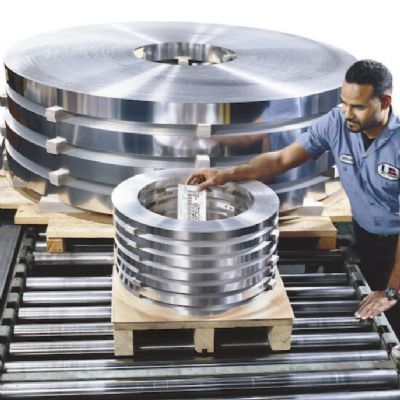Automotive Steel vs. Aluminum—Is the Tide Turning?
October 1, 2013Comments
In May, aluminum rolled-products manufacturer Novelis joined forces with ThyssenKrupp Tailored Blanks to begin developing tailored aluminum blanks. The ability to custom-fabricate blanks of varying grades and gauges of aluminum will undoubtedly attract the attention of automotive engineers. Such a breakthrough may—and likely will—open the door to expanding automotive-aluminum applications. We’re talking lightweight closures as well as structural components—cross members, longitudinal members and the like.
I see this as a significant development in the never-ending race to light-weight vehicles yet optimize crash performance. The latest carrot in the race, of course, is the recent federal mandate to achieve fleet-average fuel economy of 54.5 miles/gal. by 2025.
For sure the steel industry has done an amazing job getting us to this point. It has doubled the available grades of steel since 2000, according to the American Iron and Steel Institute, adding alloys as much as five times stronger than their predecessors. But now it looks like we’re at the start of a new stage in the race for vehicle-material consumption, and the aluminum industry has trained hard to prepare. Huge shifts already have occurred in the pickup-truck and SUV segments, and the momentum has shifted.
The impact on metalformers? Well, most aluminum to date in vehicles has been in engines and transmissions. We’ll undoubtedly see its use grow in body and structural parts, meaning that metalformers must become experts in working with aluminum. Case in point: the shift from steel to aluminum stamping under at window-regulator manufacturer Hi-Lex Controls, subject of a case-study article beginning on page 20 of this issue. Window-regulator stampings have primarily been from galvanized steel, but not for long. By mid-2013, the majority of Hi-Lex’s regulator rails will be of aluminum. That has the company’s pressroom learning new stamping techniques, as described in my article. Included is diligent cleaning of coil-feed rolls, and the use of servo-press technology.
We’re going to follow this trend closely and continue to provide our readers with all of the latest technology and techniques being developed to stamp and fabricate aluminum parts and assemblies. And, this issue, which spotlights the upcoming FABTECH tradeshow, includes an unbelievable array of new metalforming technology ready to address just about any challenge/opportunity you can think of. Read on, and we’ll see you in Chicago at FABTECH.
Oversight
Last month, I wrote about celebrating diversity, and seeking s to draw perspectives and ideas from throughout the company regardless of background, ethnicity and cultural heritage. I’m afraid I left out one very important segment of our diverse workforce—the gay, lesbian, bisexual and transgender folks working in our metalforming plants.
More than one reader reminded me of this oversight, and for that I apologize. So don’t forget to celebrate June as gay pride month. The goals remain the same—make every employee feel understood and appreciated, and you’re more likely to make them feel like true team members, ready and willing to contribute their brainpower as well as their brawn.Technologies: Materials








